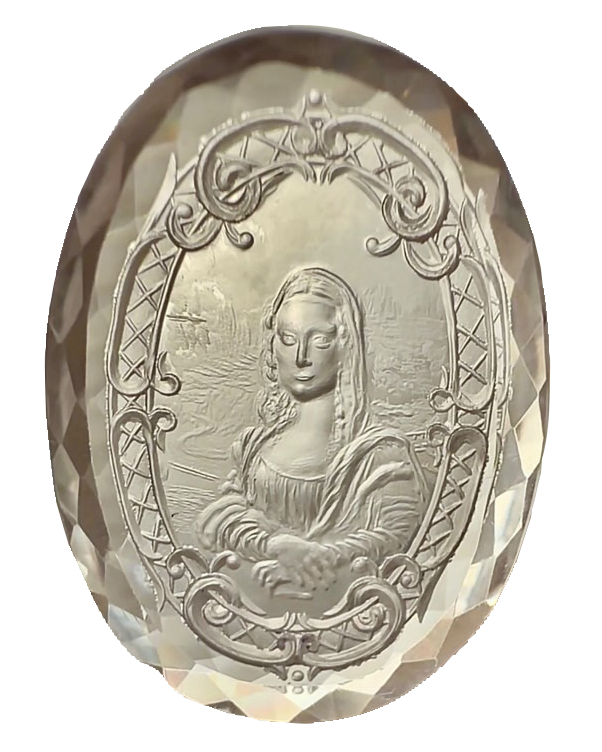Jewellers carve profitable niche from the intaglio renaissance

Whiling away lockdown in Birmingham, Ben Steele, a second-generation jeweller, stumbled across an Instagram account that captivated him. It belonged to a jeweller in New York called Christopher Ser. What Steele found so intriguing was Ser’s modern take on the intaglio — the carving of intricate designs, often portraits, into gemstones, which was popular in ancient Rome and Greece, and enjoyed a revival in 19th-century Europe.
“I just thought, I’ll have a go at that,” laughs Steele. Despite being in the jewellery trade since the age of 16, when he became an apprentice to his father, Andrew Steele, who has worked on pieces for the British royal family, he had never seen anything like what was on his screen. He had a good understanding of ancient intaglios but realised that modern intaglios didn’t have to mimic the past; gemstones could be a canvas for fresh ideas.
His first attempt, he admits, was not very good. “The first drill I had [to do the carving] was a horrible Dremel thing that was just in the house, and the end of it rattled,” he says.
Steele has since upgraded his toolbox with drills that lend more precision to the difficult task of carving in miniature. Not only does he have to create his artworks at an impossibly small scale — aided by a microscope that his late grandfather bought for him shortly before he passed away (one bit of kit he refuses to replace as his business picks up pace) — he has to do them backwards. Intaglios are carved on the reverse of the gem to be viewed through the smooth surface, so everything is flipped. “That is a challenge in itself,” he smiles wryly.
The first intaglio Steele decided to sell was a clear topaz with a skull carved into it. “I put it up [on Instagram] and it sold within half an hour,” he says. “That was the lightbulb moment [when I knew] there was something in it.”


Steele has expanded his repertoire over the past four years, creating complex carvings, including St George battling a dragon, a framed “Mona Lisa”, and a hyper-realistic horse in motion. He now takes commissions, creating portraits of people and pets for private orders from all over the world. “I’ve just had someone fly rings out to Saudi [Arabia] to be presented to some VIPs there,” he says, sounding a little baffled at his success.
Intaglios have enjoyed a distinct revival in recent years, and there is now a clutch of craftsmen around the world making modern interpretations, including master carver Michael Peuster in Germany’s famous gem-cutting hub, Idar-Oberstein.
“In the past five years, the intaglio engraving technique has experienced a renaissance — the demand is high,” says Peuster. He notes that the use of modern tools such as diamond-tipped drills has pushed the boundaries of what is possible compared with Roman times.
One of Peuster’s specialities is Essex crystal, a technique that originated in the 19th century and calls for the gemstone engravings to be painted over with oil paints. “These pieces require exceptional craftsmanship and attention to detail,” says Italian jeweller Francesca Villa, who has released a collection of jewellery set with Essex crystal intaglios, hand-carved and painted in Germany by a different artisan.
“They begin by using fine steel tools to carve deep into the back of a rock crystal cabochon,” explains Villa. “Every detail is meticulously etched into the stone and, because the carving is done in reverse, the artisans have to work with an extraordinary level of foresight and skill to achieve the desired outcome.
“Once the carving is complete, they move on to the painting process. This stage involves the use of incredibly fine brushes, sometimes with bristles no thicker than a single hair, to add colour and depth to the design.”
b


Villa is a fan of incorporating vintage elements in her work, such as old American casino chips. But working with new, rather than vintage, intaglios allows her to offer customisation. Pet portraits are a particular favourite with clients — and a growing trend in jewellery.
For Shari Cohen, founder of San Diego-based Seal & Scribe, which has built its name on setting antique glass seals and intaglios into contemporary jewellery designs, commissioning modern intaglios is a way to get around the unrepeatable nature of the originals she usually trades in.
“We have experimented with newly carved seals when an antique seal is particularly popular,” she says, giving an example of an antique arrow-through-the-heart seal that was set in a signet ring. Such was the fervour over it, Seal & Scribe commissioned a carver to repeat the design on a synthetic ruby, and now sells it set on a repeatable necklace, playfully titled Everlasting Love Hearts & Arrows.
While traditional motifs seem to remain popular with intaglio fans (last year, a ring with a garnet intaglio bearing a portrait of what was thought to be Augustus Caesar was listed for £150 at auctioneer Fellows, then sold for £90,000) the beauty of modern versions is that inspiration can strike anywhere.


“I was visiting Montauk Point Lighthouse [in New York state] and was inspired by antique whaling art,” explains Renna Brown-Taher. Her brand, Renna, then released a collection of intaglio jewellery, called Caspian, featuring octopus motifs, which were sketched by a local artist before being carved by a master intaglio maker.
“The iterations reminded me of Wes Anderson’s The Life Aquatic with Steve Zissou. Anderson’s films are so utterly immersive and transportive — a triumph I’m constantly trying to replicate with my jewellery.”
Steele says that, even though his signature is contemporary, he feels deeply connected to the intaglio masters of the ancient past. “You can go to the British Museum and see [intaglios] that are thousands of years old, that have stood the test of time, and maybe mine will be sat in a gallery somewhere in thousands of years,” he muses.
Then, at least, he jests, the havoc his newfound miniature art form is wreaking on his eyesight will be worth it.
#Jewellers #carve #profitable #niche #intaglio #renaissance






